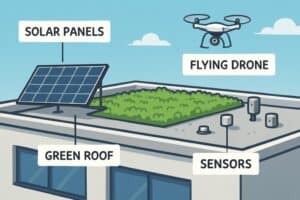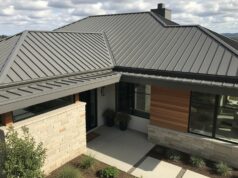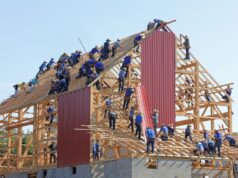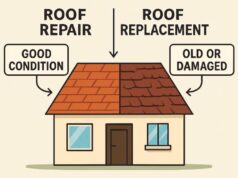Table of Contents
- Introduction
- Smart Roofing Systems
- Drone Technology for Inspections
- Sustainable Roofing Materials
- Advanced Waterproofing Solutions
- Solar-Integrated Roofing
- Robotics in Roof Installation
- Augmented Reality in Roofing
- Building Information Modeling
Introduction
Commercial roofing is experiencing a transformative era driven by rapid technological advancements and a mounting demand for sustainability. For companies planning a large commercial roof install, these innovations promise to improve durability, energy efficiency, and environmental responsibility. Adopting the latest technologies ensures long-term savings and boosts building performance, aligning with modern business goals.
As new materials and techniques emerge, commercial roofing becomes more adaptive to climate change, safety requirements, and the unique operational needs of diverse industries. Today’s innovations are not simply about covering a building but about optimizing and protecting multi-million dollar investments for decades.
Smart Roofing Systems
Smart roofing is redefining preventive maintenance in commercial properties. With the integration of Internet of Things (IoT) technology, sensors embedded in roofing assemblies now offer real-time data on temperature fluctuations, moisture intrusion, weather exposure, and general structural health. This constant stream of information enables facility managers to schedule maintenance before minor issues escalate into major repairs, thus preventing leaks and reducing overall maintenance costs.
Systems capable of early leak detection and automated fault notifications mean less downtime and fewer business interruptions, translating into significant savings and peace of mind for property owners and managers.

Drone Technology for Inspections
The adoption of drones in commercial roofing has revolutionized inspection protocols. Drones equipped with high-resolution cameras, infrared scanners, and thermal imaging technology can efficiently spot hidden problems such as insulation voids, pooling water, or punctures. This technology allows thorough assessments without needing inspectors to traverse potentially hazardous roofs.
Drones mitigate safety risks, reduce labor costs, and generate comprehensive visual records, ensuring the roof’s integrity throughout its service life. Additionally, drones are increasingly used to monitor the progress of new roof installations, providing invaluable documentation for quality assurance and transparent project oversight.
Sustainable Roofing Materials
Eco-consciousness is at the forefront of material selection in commercial roofing. Green roof systems, which replace conventional materials with vegetation layers, offer natural insulation, stormwater management, and the reduction of heat islands in urban spaces. Meanwhile, advanced synthetic membranes—such as TPO (thermoplastic polyolefin) and PVC (polyvinyl chloride)—reflect sunlight, reduce building cooling loads, and enhance energy performance.
According to Greenroofs.com, these material choices contribute not just to energy savings but also extend roof lifespan, decrease operational costs, and bolster environmental stewardship for any commercial structure.
Advanced Waterproofing Solutions
Waterproofing is critical to any roof system. Thanks to scientific advances, new self-healing membranes formed from highly flexible polymers can autonomously reseal small cracks and holes—an essential innovation for regions with severe weather fluctuations. Liquid-applied waterproof coatings further eliminate potential leak points by providing seamless, monolithic coverage that adapts to intricate architectural details.
As a result, advanced waterproofing significantly reduces repair needs, prolongs roof service life, and ensures critical business operations remain uninterrupted.
Solar-Integrated Roofing
Renewable energy solutions, such as building-integrated photovoltaic (BIPV) systems, are becoming mainstream in commercial roofing. These solar technologies are engineered to blend with traditional materials, ensuring both structural and visual compatibility. Modern BIPV panels deliver higher energy yields with slimmer profiles, empowering businesses to harness green energy without sacrificing design.
Cutting-edge solutions reduce electricity costs and support compliance with contemporary sustainability mandates. Projects embracing solar integration can benefit from tax incentives and national energy credits, further enhancing long-term return on investment.
Robotics in Roof Installation
The rise of robotics in commercial construction is transforming labor-intensive projects. Automated tools and machines streamline tasks such as shingle placement and waterproof membrane application, ensuring uniformly high-quality installation at an accelerated pace. Robotics drastically minimizes risk to human workers by reducing the need for manual lifting and exposure to dangerous heights.
This level of automation is especially beneficial for large commercial structures, where even small inefficiencies can have major financial impacts over time.
Augmented Reality in Roofing
Augmented reality (AR) applications are increasingly used for project planning and workforce training. AR overlays digital schematics or repair instructions onto physical structures, helping teams visualize complex upgrades and execute precision repairs. By simulating on-the-job scenarios, AR platforms aid in skills development and foster a culture of accuracy and safety in the industry.
Consequently, AR not only boosts the efficiency of roofing professionals but also enhances stakeholder communication throughout the project’s lifetime.
Building Information Modeling
Building Information Modeling (BIM) enables the digital visualization and coordination of all aspects of a roofing project. BIM streamlines estimating, material purchasing, and scheduling, reducing waste and driving cost efficiencies. More importantly, BIM supports collaborative workflows among architects, engineers, and contractors, ensuring compliance with performance standards at every construction stage.
Once in operation, BIM models facilitate asset management by giving property managers the tools for efficient resource allocation and long-term maintenance planning.
As commercial roofing evolves, staying at the forefront of technological innovation delivers measurable rewards in terms of performance, sustainability, and cost control. Businesses equipped with the latest roofing solutions are better positioned to protect their investments, support their occupants, and fulfill environmental responsibilities in an ever-changing marketplace.





